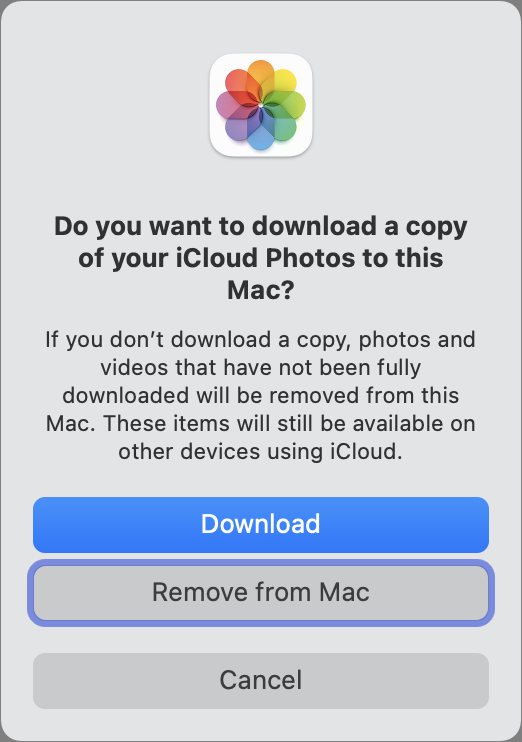iCloud Photos’ mission is to sync photos and video across all your devices, providing access to a single set of media across your hardware and via iCloud.com. Not everybody wants that, however. Some people want different sets of media on different devices. That’s possible, but it comes with risk and challenges.
If you don’t have iCloud Photos already set up, you can skip ahead to the section on backing up media without using iCloud.
Switching from iCloud Photos to locally stored media
If iCloud Photos is enabled on one or more of your devices—that’s on any iPhone, iPad, iPod touch, or Mac—some copy of your entire set of images and movies are on each device. Because many mobile devices lack the storage to keep a full copy of your iCloud Photos library, it may be set to optimized storage, which retains low-resolution thumbnails of each piece of media.
You can check whether Optimize iPhone/iPad/Mac Storage is enabled in these locations:
- In iOS and iPadOS, go to Settings > account name > Photos
- In macOS, open Photos and go to Photos > Preferences > iCloud. (This can also be set through the iCloud preference pane in 10.14 Mojave and earlier and the iCloud view in the Apple ID preference pane in 10.15 Catalina and later.)
If your set of synced media is optimized, then you don’t have a full-resolution version of all images and videos on that device. Make sure one of your devices does (most likely a Mac), and that it has enough storage to download the full library. The easiest method is to force Photos to perform a download:
- In Photos for macOS, go to Photos > Preferences > iCloud Photos.
- If you don’t have Download Originals to this Mac checked, do so. This will start a full download.
- Uncheck the iCloud Photos box.
- Photos prompts you to confirm, but offers two choices. Pick Download, which ensures that all images in any state are downloaded to your Mac.
 https://b2c-contenthub.com/wp-content/uploads/2021/09/mac911-download-icloud-photos-mac.png?resize=211%2C300&quality=50&strip=all 211w" width="522" height="742" sizes="(max-width: 522px) 100vw, 522px" />
https://b2c-contenthub.com/wp-content/uploads/2021/09/mac911-download-icloud-photos-mac.png?resize=211%2C300&quality=50&strip=all 211w" width="522" height="742" sizes="(max-width: 522px) 100vw, 522px" />Photos prompts you to download a complete set of media when you disable iCloud Photos.
When the operation is complete, iCloud Photos will be disabled and you’ll have a full local copy.
I’d suggest waiting until that point before you disable iCloud Photos on devices that you don’t want to continue syncing with and via iCloud.
Your media remains on iCloud.com as a backup even if you disable all devices from syncing with it. But it’s no longer kept up to date with any device that has iCloud Photos disabled.
Also, if you were paying for a tier of iCloud with enough storage to contain your library—above the free 5GB tier—downgrading your storage plan will effectively delete any media storage for photos and videos above the level you downgraded to. If you have a 100GB library and downgrade to 50GB of storage, that 50GB has to go somewhere—and that’s into the bit bucket.
On devices that no longer have iCloud Photos enabled, any images you capture or add the Photos library are retained only locally. This suddenly becomes your responsibility to back up—not Apple’s for iCloud backups of iPhones and iPads or Time Machine for Mac backups.
Backing up photos without iCloud sync
Your photos and videos are likely some of the most precious things you own, even if they only exist as bits on a computer or mobile device. Once you disable iCloud Photos on your device, images aren’t necessarily automatically backed up the moment they’re captured or added.
On a Mac, use at least Time Machine and a secure internet backup option for continuous backups; make sure you always have at least two available. Time Machine makes a backup hourly. Internet backup services may occur immediately, within a short period of time of adding or modifying files, or at regular interviews.
On an iPhone or iPad, you have to engage a bit more effort:
- Sync via a Mac: You can use iTunes in macOS Mojave or earlier or the Finder in macOS Catalina or later to sync images images from your iPhone or iPad to your Mac. This is manual, so these backups occur only when you physically connect your mobile device via USB to your Mac.
- Sync via Google Photos: Google can automatically sync photos with Google Photos installed without occupying much storage on your device. (This is also an option for macOS.) Google’s storage prices aren’t far off from Apple’s.
- Sync via Dropbox: Dropbox can automatically sync images from an iPhone or iPad using an app on the device or when you plug in a mobile device (or camera) to a Mac. Dropbox also charges about the same as Apple for cloud storage.
This Mac 911 article is in response to a question submitted by Macworld reader Elizabeth.
Ask Mac 911
We’ve compiled a list of the questions we get asked most frequently, along with answers and links to columns: read our super FAQ to see if your question is covered. If not, we’re always looking for new problems to solve! Email yours to mac911@macworld.com, including screen captures as appropriate and whether you want your full name used. Not every question will be answered, we don’t reply to email, and we cannot provide direct troubleshooting advice.





